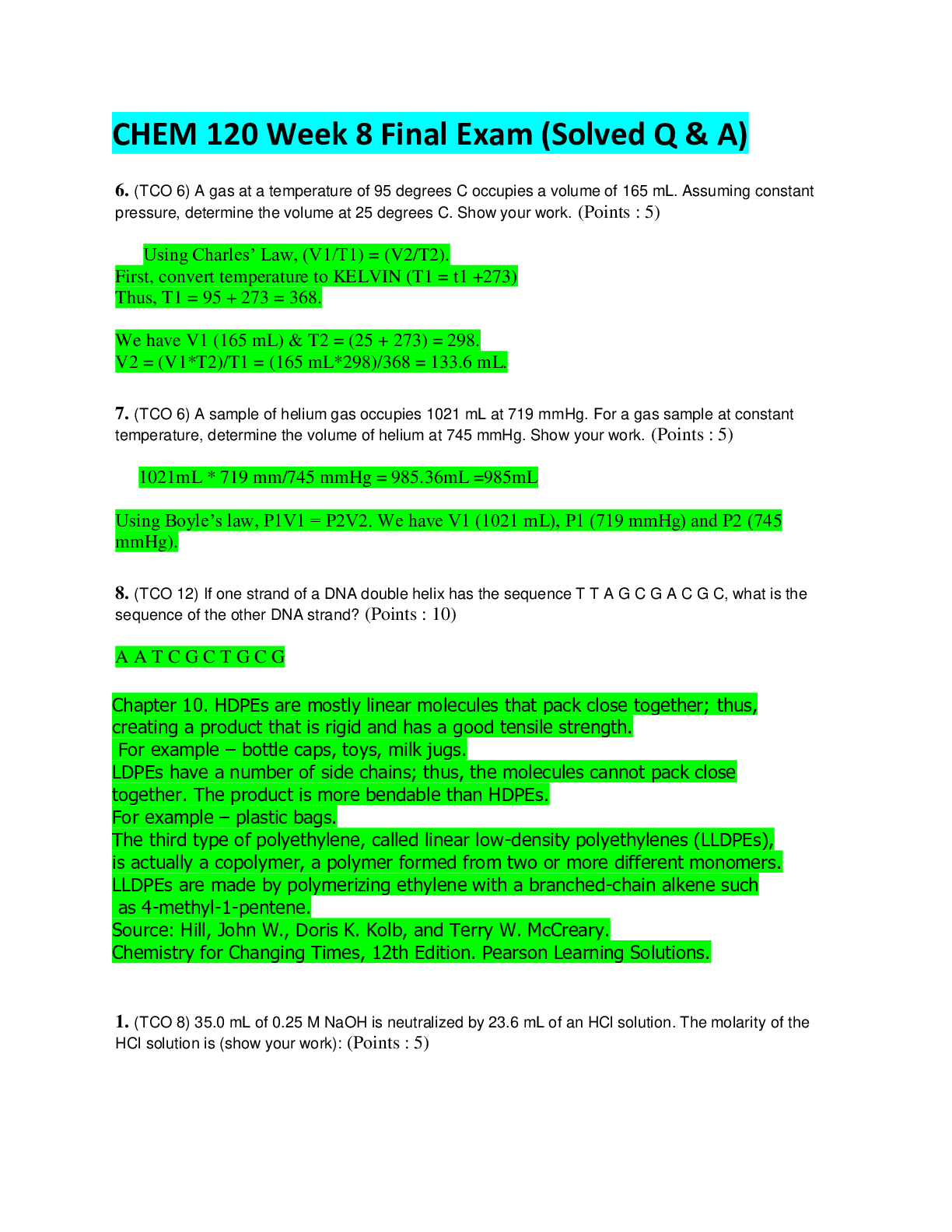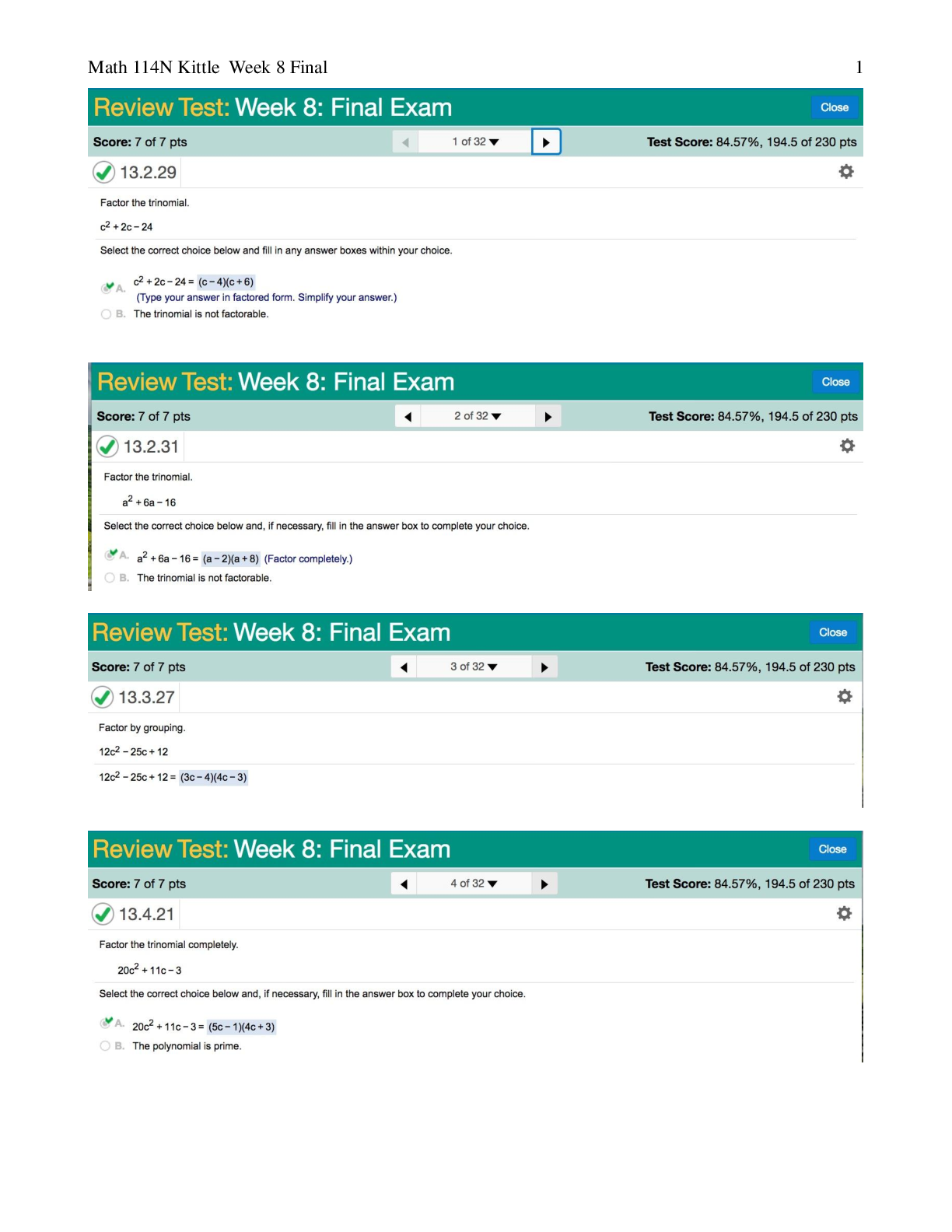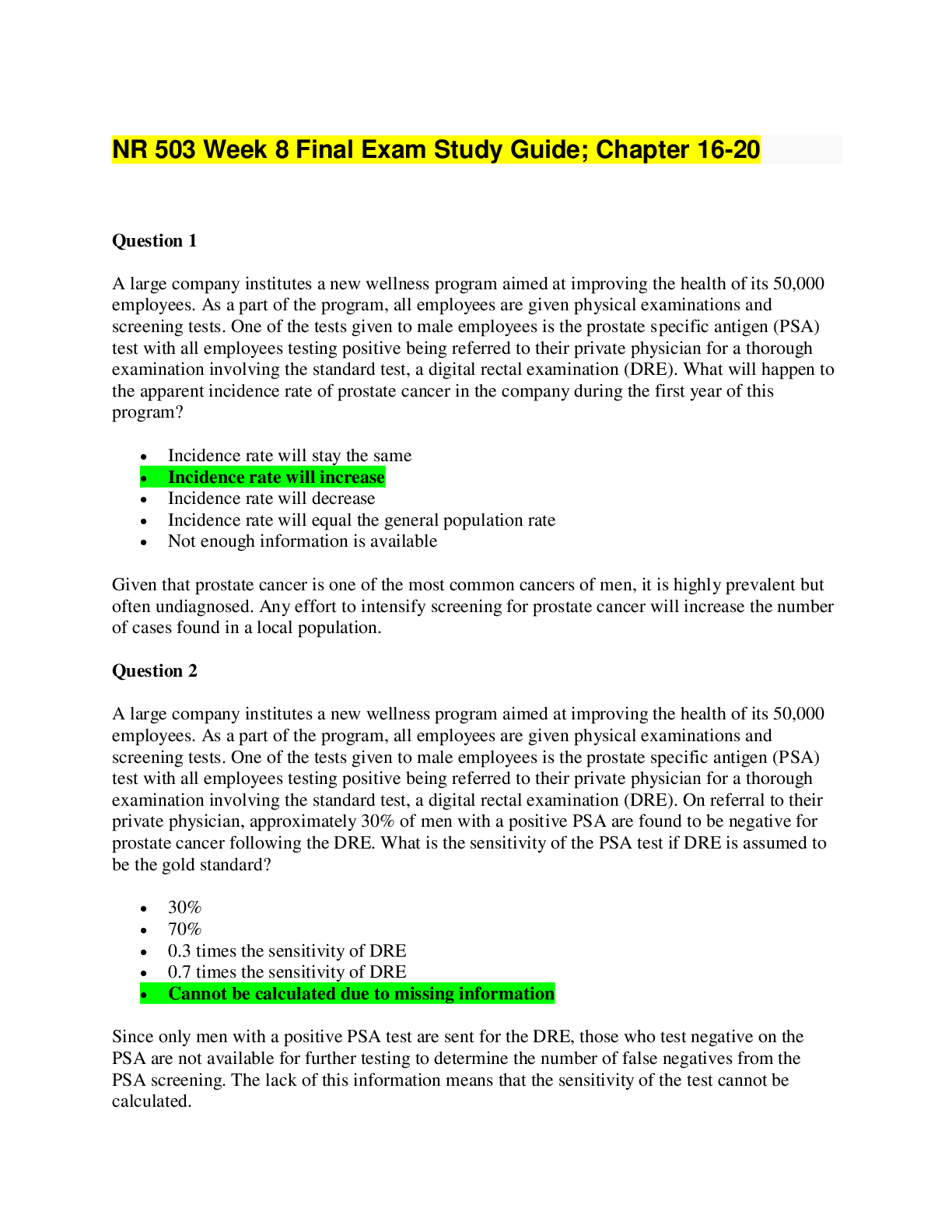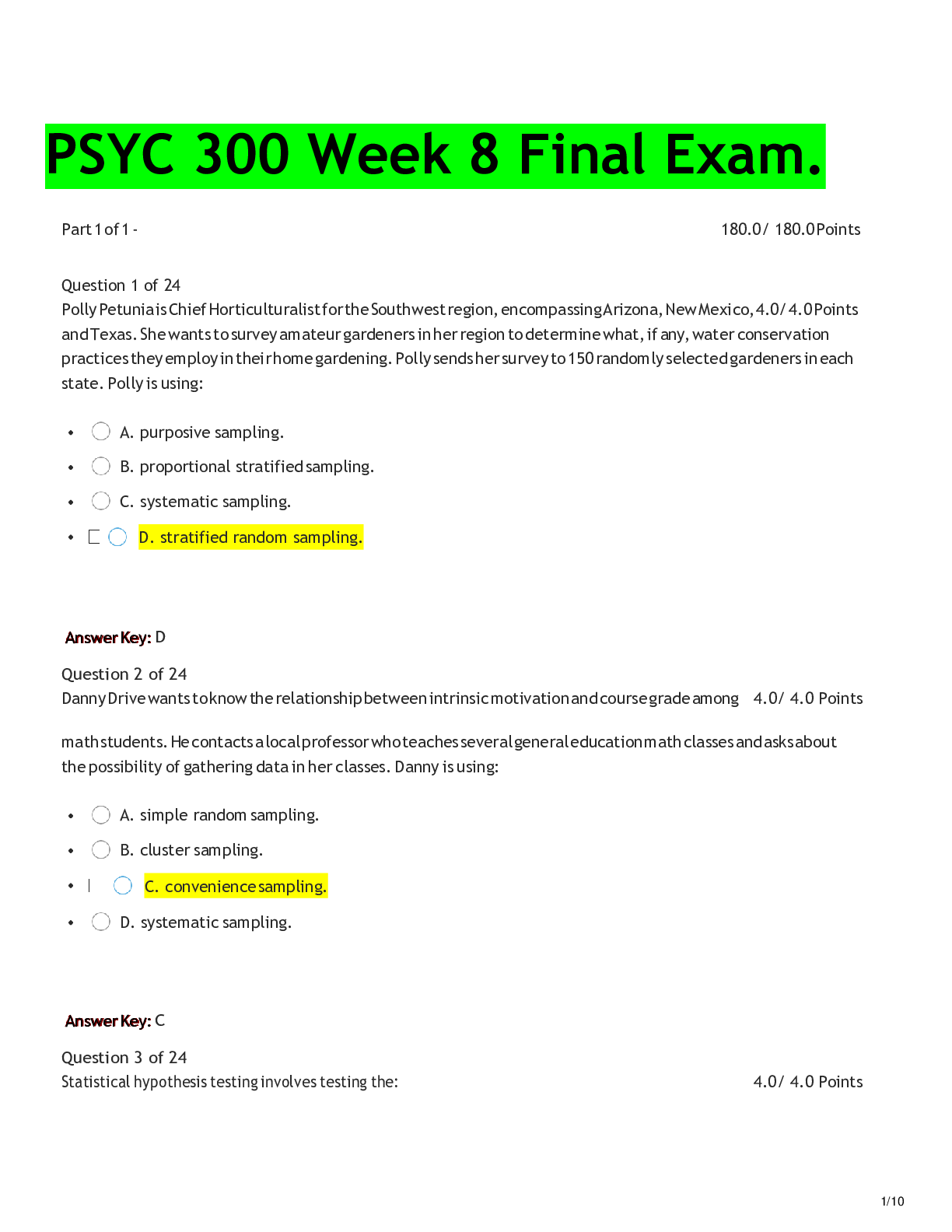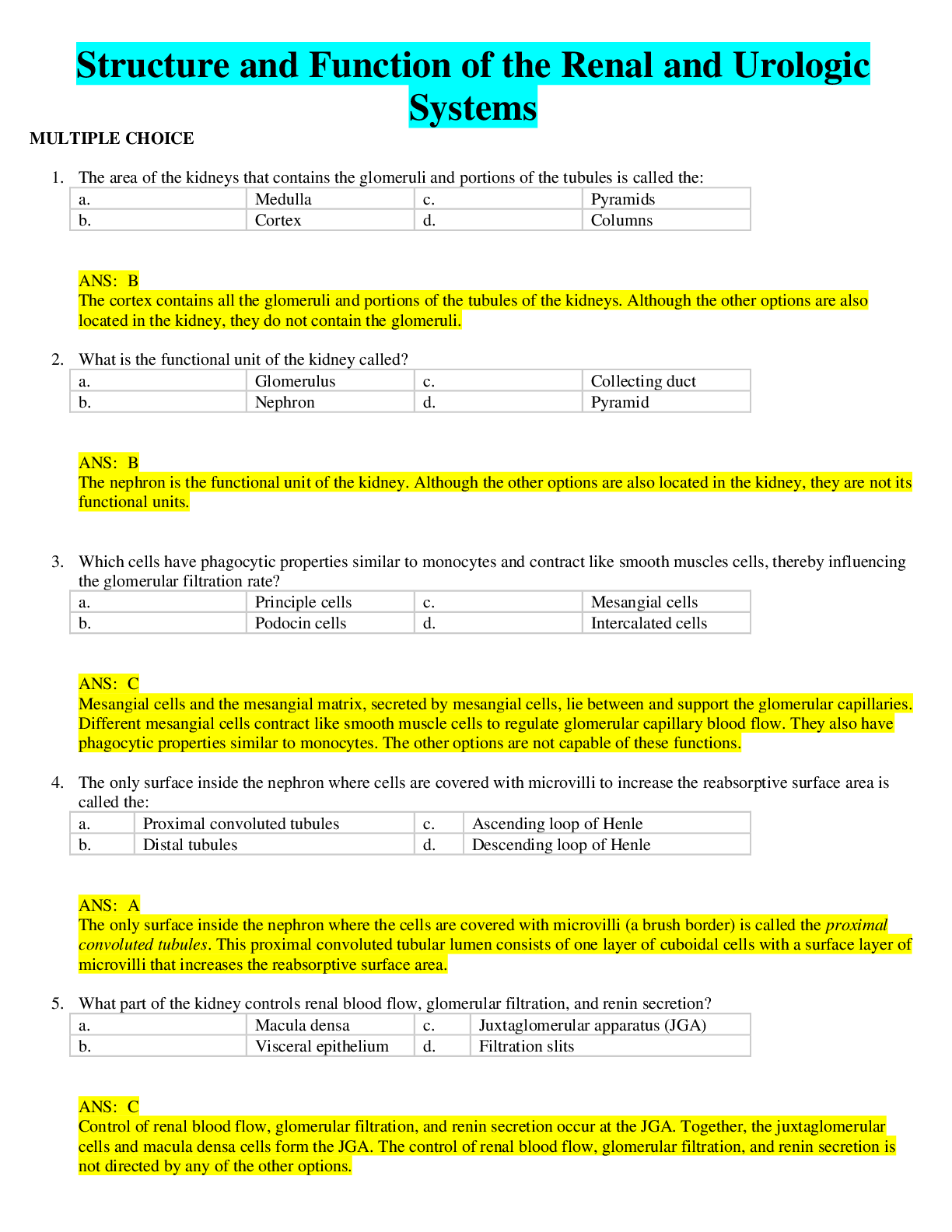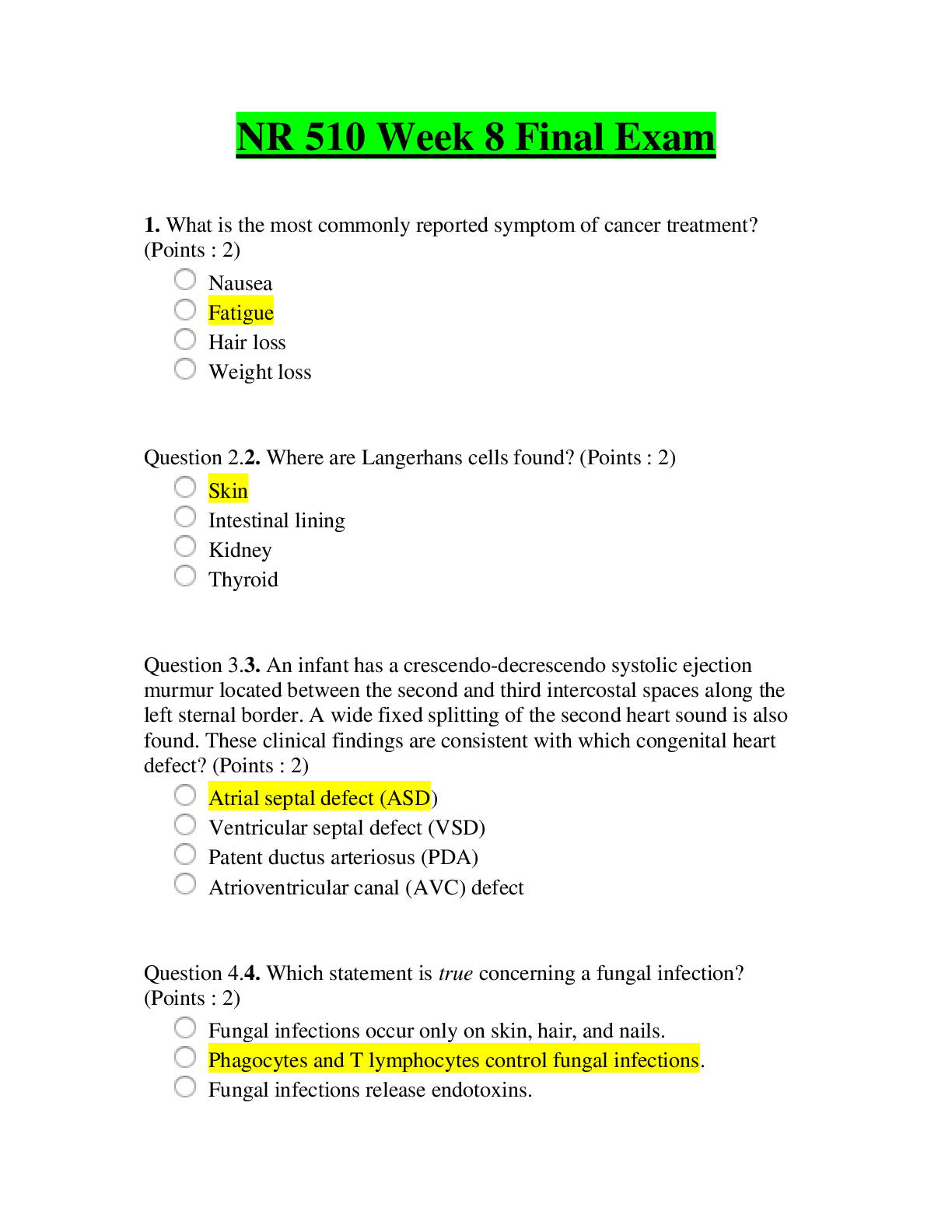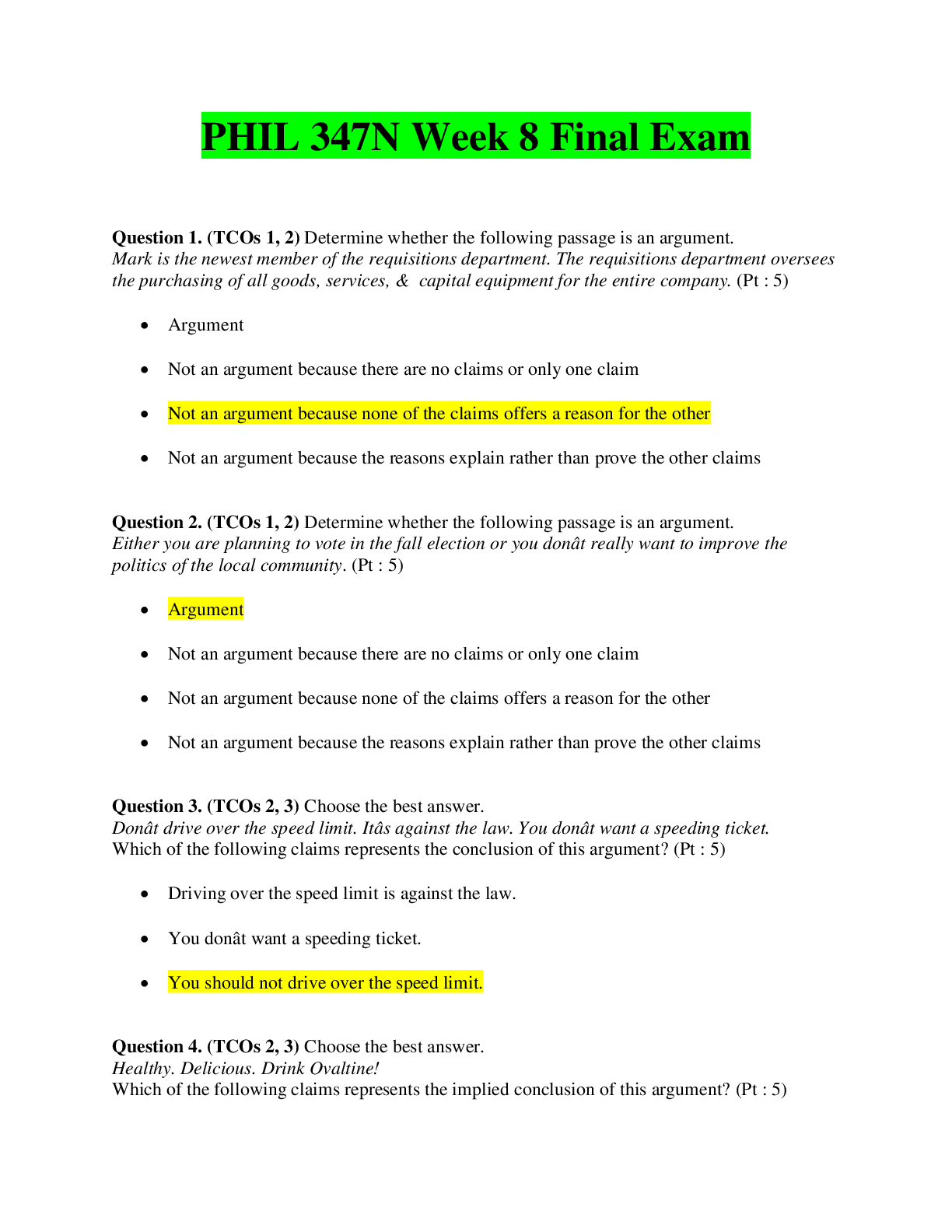*NURSING > QUESTIONS & ANSWERS > NR 511 Week 8 Final Exam Practice Questions-Answers (Term 2020-v2) (All)
NR 511 Week 8 Final Exam Practice Questions-Answers (Term 2020-v2)
Document Content and Description Below
Question: Matthew, age 52, is a chef who just severed 2 of his fingers with a meat cutter. You would recommend that he: Question: The valgus stress test, varus stress test, Lachman test, and thumb si... gn are all considered standard tests to check the integrity of the ligaments of the knee. Which test would the nurse practitioner choose to assess the anterior cruciate ligament (ACL), which is the most commonly involved structure in severe knee injury? Question: Lillian, age 70, was told that she has osteoporosis. When she asks you what this is, you respond that osteoporosis: Question: Mike, age 42, a golf pro, has had chronic back pain for many years. His workup reveals that it is not the result of a degenerative disk problem. His back “goes out” about twice per year, and he is out of work for about a week each time. Which of the following should the nurse practitioner advise him to do? Question: Janine, age 69, has class III rheumatoid arthritis. According to the American Rheumatism Association, which of the following describes her ability to function? Question: For an adult patient with a knee injury, the nurse practitioner orders a nonsteroidal anti-inflammatory drug (NSAID) to be taken on a routine basis for the next 2 weeks. Patient teaching should include which of the following? Question: Sean, a factory line worker, has osteoarthritis (OA) of the right hand. According to the American College of Rheumatology (ACR), the guidelines for pharmacologic treatment include: Question: Margaret, age 55, presents to you for evaluation of left hand and wrist pain and swelling after a slip and fall on the ice yesterday. On examination, you note tenderness at her “anatomical snuffbox.” You know this probably indicates a(n): Question: Jim, age 22, a stock boy, has an acute episode of low back pain. The nurse practitioner orders a nonsteroidal anti-inflammatory drug (NSAID) and should educate him in which of the following? Question: Jessie, age 49, states she thinks she has rheumatoid arthritis. Before any … tests are ordered, the nurse practitioner completes a physical examination and makes a diagnosis of osteoarthritis rather than rheumatoid arthritis. Which clinical manifestation ruled out rheumatoid arthritis? Question: Greg, age 26, runs marathons and frequently complains of painful contractions of his calf muscles after running. You attribute this to: Question: The nurse practitioner is considering a diagnosis of calcium pyrophosphate deposition disease (CPPD), or pseudogout, in a 72-year-old man who presents with complaints of pain and stiffness in his wrists and knees. The most useful diagnostic tests to assist in confirming this diagnosis would be: Question: Ethan, age 10, jumped off a 2-foot wall, twisting his foot and ankle upon landing. His ankle x-ray demonstrates a fracture of the distal tibia, over the articular surface, through the epiphysis and physis (growth plate). Based on the Salter-Harris classification of growth plate injuries, you know this is a: Question: In assessing a patient, you place the tips of your first 2 fingers in front of each ear and ask the patient to open and close his mouth. Then you drop your fingers into the depressed area over the joint and assess for smooth motion of the mandible. With this action, you are checking for: Question: Sandra, a computer programmer, has just been given a new diagnosis of carpal tunnel syndrome. The nurse practitioner’s next step is to: Question: Alexander, age 12, sprained his ankle playing ice hockey. He is confused as to whether he should apply heat or cold. What should the nurse practitioner tell him? Question: Daniel, age 45, is of Northern European ancestry and has a dysfunctional and disfiguring condition affecting the palmar tissue under the skin of the distal palm and fourth and fifth fingers. What do you suspect? Question: Paul has a malignant fibrosarcoma of the femur. He recently had surgery and is now on radiation therapy. You want to order a test to determine the extent of the tumor invasion of the surrounding tissues and the response of the bone tumor to the radiation. Which of the following tests should you order? Question: Lois, age 52, who has just been given a diagnosis of sarcoidosis, has joint symptoms, including arthralgias and arthritis. Your next plan of action would be to: Question: The nurse practitioner (NP) is … Maya, a 69-year-old Asian woman, for the first time. When trying to differentiate between scoliosis and kyphosis, the NP recalls that kyphosis involves: Question: Marsha, age 34, presents with symptoms resembling both fibromyalgia and chronic fatigue syndrome, which have many similarities. Which of the following is more characteristic of fibromyalgia than of chronic fatigue syndrome? Question: Upon assessment, the nurse practitioner notes unilateral back pain of acute onset that increases when standing and bending. A straight leg raise test is negative. The most likely diagnosis is: Question: A 55-year-old patient presents with complaints of paresthesias in the lower lateral arm, thumb, and middle finger. The nerve roots most commonly related to these symptoms are C6 and C7. The most likely diagnosis would be: Question: Christian, age 22, is a carpenter who is right hand dominant. He comes to the clinic for follow-up from the emergency department, where he was seen for right forearm pain. He states he was diagnosed with right forearm tendinitis and wants the provider to explain this diagnosis to him. Patient teaching should explain that he has inflammation of one or more tendons, which are: Question: Steve, age 32, fell off a roof while shingling it. He is complaining of pain in his left hip and leg area. Other than an x-ray, what would make you suspect a fractured pelvis? Question: Beth, age 49, comes in with low back pain. An x-ray of the lumbosacral spine is within normal limits. Which of the following diagnoses do you explore further? Question: Joyce, age 87, broke her wrist after falling off a curb. She just had a plaster cast applied to her wrist. In instructing Joyce and her family on allowing the cast to dry properly, tell them to: Question: When teaching Alice, age 77, to use a cane because of osteoarthritis of her left knee, an important point to stress is: Question: You are caring for a patient who has a history of psoriasis and is now showing signs of joint involvement. Seropositivity provides a definitive diagnosis of psoriatic arthritis (PsA). The initial treatment choice for management of the patient is: Question: Hilda, age 73, presents with a complaint of low back pain. Red flags in her history of a minor fall, osteopenia, and prolonged steroid use for systemic lupus erythematosus suggest the possibility of which of the following serious underlying conditions as the cause of her low back pain? Question: A nurse practitioner is driving home from work and stops at the scene of a motorcycle accident that must have just occurred, as there are no rescue vehicles present. The driver is lying unconscious at the side of the road with an obvious open fracture of his femur. Which of the following actions should take priority? Question: Mr. McKinsey, age 69, was recently given a diagnosis of degenerative joint disease. Which assessment should the nurse practitioner use to check for effusion of the patient’s knee? Question: Sam, age 50, presents with Paget disease that has been stable for several years. Recently, his serum alkaline phosphatase level has been steadily rising. The nurse practitioner determines that it is time to start him on pharmacologic management. Which of the following should she initially prescribe? Question: James, age 17, has been complaining of a painful knob below his right knee that has prevented him from actively participating in sports. He has recently been given a diagnosis of Osgood-Schlatter disease and asks you about his treatment options. The nurse practitioner should tell him that the initial treatment is: Question: The nurse practitioner (NP) suspects a herniated disk in a 72-year-old patient. The NP elevates the patient’s affected leg when she is in the supine position, and it elicits back and sciatic nerve pain, which indicates a positive test. This is known as which test or sign? Question: Jill, age 49, has recently begun a rigorous weightlifting regimen. She presents to the primary care office with a shoulder dislocation. Which of the following clinical manifestations leads the nurse practitioner to suspect an anterior shoulder dislocation over a posterior dislocation? Question: Karen, who is postmenopausal, is taking 1200 mg of calcium daily but does not understand why she also needs to take vitamin D. You tell her that: Question: Sigrid, age 48, appears with a 3-month history of heat intolerance, increased sweating, palpitations, tachycardia, nervousness, irritability, fatigue, and muscle weakness. Which test would you order first? Question: Eunice, age 32, has type 2 diabetes. She said she heard she should take an aspirin a day after she reaches menopause for its cardioprotective action. She does not have coronary artery disease, but her father does. How do you respond? Question: Marie, age 50, has type 1 diabetes and checks her blood glucose level several times every day. Her blood glucose level ranges from 250 to 280 mg/dL in the morning and is usually about 140 at lunch, about 120 at dinner, and about 100 at bedtime. In the morning, she takes 30 units of neutral protamine Hagedorn (NPH) insulin and 4 units of regular insulin, and before dinner she takes 18 units of NPH insulin and 4 units of regular insulin. Although she has had her insulin dose adjusted several times in the past month, it has had no effect on her high morning blood glucose level. What is your next course of action? Question: Which class of antihypertensive agents may be problematic for clients with diabetes? Question: Marty has pheochromocytoma. You instruct him to: Question: Jeffrey, age 17, has gynecomastia. You should also assess him for: Question: Jeremiah, age 72, has gout and is obese. When teaching him about diet, which of the following do you tell him? Question: An elderly client presents with atrial fibrillation. Which of the following lab tests is important in forming the diagnosis? Question: Martin, age 62, has acute nontransient abdominal pain that grows steadily worse in the epigastric area and radiates straight through to the back. The pain has lasted for days. He is also complaining of nausea, vomiting, sweating, weakness, and pallor. Physical examination reveals abdominal tenderness and distention and a low-grade fever. What do you suspect? Question: Leah, age 70, has had diabetes for many years. When teaching her about foot care, you want to stress: Question: Betty, age 40, has had type 1 diabetes for 20 years and takes a combination of neutral protamine Hagedorn (NPH) and regular insulin every day. She comes to the office because she has developed a severe upper respiratory infection with chills, fever, and production of yellow sputum. Because of her acute infection, you know that Betty is likely to require: Question: A client with hyperthyroidism presents with a complaint of a “gritty” feeling in her eyes. Over the past week, her visual acuity has diminished, and her ability to see colors has changed. She also has a feeling of pressure behind her eyes. The next step for the nurse practitioner is to: Question: Morton has type 2 diabetes. His treatment, which includes diet, exercise, and 3 oral antidiabetic agents at maximum dose, is insufficient to achieve acceptable glycemic control. Your next course of action is to: Question: Jay has had diabetes for 10 years. He recently had a physical and was told he has some evidence of nephropathy. What is the first manifestation of this condition? Question: QuestionSadie, age 40, has just been given a diagnosis of Graves disease. She has recently lost 25 lb, has palpitations, is very irritable, feels very warm, and has a noticeable bulge on her neck. The most likely cause of her increased thyroid function is: Question: A patient presents to your primary care office with abnormal lab results. On physical exam, you tap the patient’s facial nerve around the zygomatic arch, just anterior to the earlobe. This describes which of the following tests and is associated with which of the following lab abnormalities? Question:Which of the following conditions is a common pathological cause of hirsutism? Question: What is the primary pathological irregularity associated with diabetes mellitus type 1? Question: Which of the following is not a risk factor for diabetes mellitus type 2? Question: A 55-year-old Asian male presents with a history of severe left great toe pain. He states he cannot even touch the toe with a sheet without it causing pain. He denies trauma but states he cannot ambulate without pain. He admits to drinking alcohol but not to excess. On physical exam, he has normal vital signs, and you note erythema of the great toe at the interphalangeal (IP) joint. Which of the following is the gold standard for diagnosis of this problem? Question: What is the medication of choice for an initial acute attack of gout? Question: The process of aging results in: Question: A client with newly diagnosed diabetes who has a glycated hemoglobin (HbA1c) of 7.5 is started on therapeutic lifestyle changes (TLCs) and medical nutrition therapy (MNT). Which oral antidiabetic agent is recommended as monotherapy? Question: Reynolds is on the antithyroid drug (ATD) methimazole (Tapazole), so you make it a point to check his: Question: After an oral cholecystogram, Sam complains of burning on urination. This is because of: Question: Ben, a client with type 1 diabetes, is hospitalized with an admitting diagnosis of diabetic ketoacidosis (DKA). Which of the following signs and symptoms would be consistent with this condition? Question: Your client with diabetes asks you about insulin glargine (Lantus). You tell her that: Question: Jennifer has diabetes mellitus (DM) and is injecting 30 units of Novolin 70/30 with breakfast and 18 units at bedtime. She is complaining that she woke up once in the middle of the night with palpitations and sweating. Based on this information, what do you recommend? Question: Dan, age 45, is obese and has type 2 diabetes. He has been having trouble getting his glycohemoglobin under control. He has heard that exenatide (Byetta) causes weight loss and wants to try it. What do you tell him? Question: You suspect that Sharon has hypoparathyroidism because, in addition to her other signs and symptoms, she has: Question: Morris has had type 1 diabetes for 10 years. Several recent urinalysis reports have shown microalbuminuria. Your next step would be to: Question: Jason, age 14, appears with tender discoid breast tissue enlargement (2-3 cm in diameter) beneath the areolae. Your next action would be to: Question: What is the most common cause of gynecomastia? Question: QuWhat is the most common cause of Cushing disease? Question: Which of the following statements about metformin is untrue? Question: Which of the following body mass index (BMI) values defines class 1 obesity? Question: Joan has severe asthma and has been on high doses of oral corticosteroids for 2 years. She has been reading some home remedy books and stops all of her medications. What condition may she develop? Question: The most common cause of hyperthyroidism is: Question: Steve, age 42, has never been hypertensive but appears today in the office with a blood pressure of 162/100 mm Hg. He also complains of “attacks” of headache, perspiration, and palpitations, with frequent bouts of nausea, pain, weakness, dyspnea, and visual disturbances. He has lost 10 lb over the past 2 months and seems very anxious today. Your next action would be to: Question: Question: Jenny, age 46, has hypertension that has been controlled with hydrochlorothiazide 50 mg every day for the past 3 years. She is 5 ft 8 in tall and weighs 220 lb. Her fasting blood sugar (FBS) is 300 mg/dL, serum cholesterol level is 250 mg/dL, serum potassium level is 3.4 mEq, and she has 4+ glucosuria. Your next course of action would be to: Question: Juanita, age 23, complains of palpitations that started a few weeks ago; they occur 2 to 4 times a day and last 5 to 10 minutes. She feels nervous and is having trouble sleeping. Her stools have been frequent (1-3 per day) and loose. She is taking levothyroxine 150 µg daily. Her labs indicate free thyroxine (T4) 2.28 and thyroid-stimulating hormone (TSH) 0.022. She has a history of Graves disease and had radioactive iodine (RAI) treatment a few months ago. She has been on thyroid replacement for 2 months. Based on these data, you decide to: Question: A low thyroid-stimulating hormone (TSH) can lead to: Question: Sara, age 40, has diabetes and is now experiencing anhidrosis on the hands and feet, increased sweating on the face and trunk, dysphagia, anorexia, and heartburn. Which complication of diabetes do you suspect? Question: Mary, age 72, has been taking insulin for several years. She just called you because she realized that yesterday she put her short-acting insulin in the long-acting insulin box and vice versa. She just took 22 units of regular insulin when she was supposed to take only 5 units. She says that she tried to do a fingerstick to test her glucose level but was unable to obtain any blood. She states that she feels fine. What do you tell her to do first? Question: A client with diabetes on a sulfonylurea and metformin with a glycated hemoglobin (HbA1c) of 6.5% is complaining of episodes of low blood sugar. Which of the following changes would be the most appropriate? Question: Mindy is scheduled to have an oral glucose tolerance test (OGTT). She is instructed to discontinue many of her medications for 3 days before the test. Which one is it safe to continue taking? Question: Sandra, age 28, has secondary obesity. Which of the following may have caused this? Question: Which of the following statements about hypothyroidism is not true? Question: To reduce the incidence of flares, foods high in what amino acid need to be limited in the diets of patients with gout? Question: Marsha, age 24, is preparing for radioactive iodine therapy for her Graves disease. Which test must she undergo first? Question: When teaching Marcy how to use her new insulin pump, you tell her that she needs to monitor her blood glucose level: Question: The major risk factor for thyroid cancer is: Question: The American Diabetes Association (ADA) recommends which of the following quarterly blood tests be performed on all clients with diabetes? Question: Mason, age 52, has diabetes mellitus (DM) and is overweight. You now find that he is hypertensive. How should you treat his hypertension? Question: Tamika, who has diabetes, states that she heard fiber is especially good to include in her diet. How do you respond? Question: Question 10. Mark has type 1 diabetes and has mild hyperglycemia. What effect does physical activity (exercise) have on his blood glucose level? Question: When you inspect the integumentary system of clients with endocrine disorders, a finding of coarse hair may be an indicator of: Question: Which is the only curative treatment option for primary hyperparathyroidism (PHPT)? Question: A patient presents to your primary care office complaining of polydipsia, polyuria, and polyphagia. Which of the following diagnoses would not be in your differential diagnosis? Question: A 35-year-old female presents to your primary care office for review of her laboratory results. Her physical exam shows a blood pressure (BP) of 140/90, pulse (P) of 105, oxygen saturation of 97%, and temperature of 98.6°F. She has complaints of palpitations, weight loss, hair loss, and anxiety. Her labs are all normal except for a low thyroid-stimulating hormone (TSH) and an elevated thyroxine (T4). What would your next course of treatment be? Question: A 35-year-old male presents to your office complaining of fatigue, weight loss, nausea, and abdominal pain. On physical exam, you notice he has orthostatic hypotension and hyperpigmented skin. You do a morning cortisol level, which is low. The plasma adrenocorticotropic hormone (ACTH) is elevated. How would you treat this patient? Question: Which of the following statements about diabetes mellitus is untrue? Question: Which of the following would not confirm a diagnosis of diabetes? Question: Which of the following would not be ordered on a regular basis to evaluate diabetic patients for end organ damage associated with diabetes? Question: Harriet, age 62, has type 1 diabetes that is well controlled by insulin. Recently, she has been having marital difficulties that have left her emotionally upset. As a result of this stress, it is possible that she will: Question: Lynne has Cushing syndrome. You would expect her to have or develop: Question: Joy has gout. In teaching her about her disease, which food do you tell her is allowed in the diet? [Show More]
Last updated: 1 year ago
Preview 1 out of 127 pages
Instant download
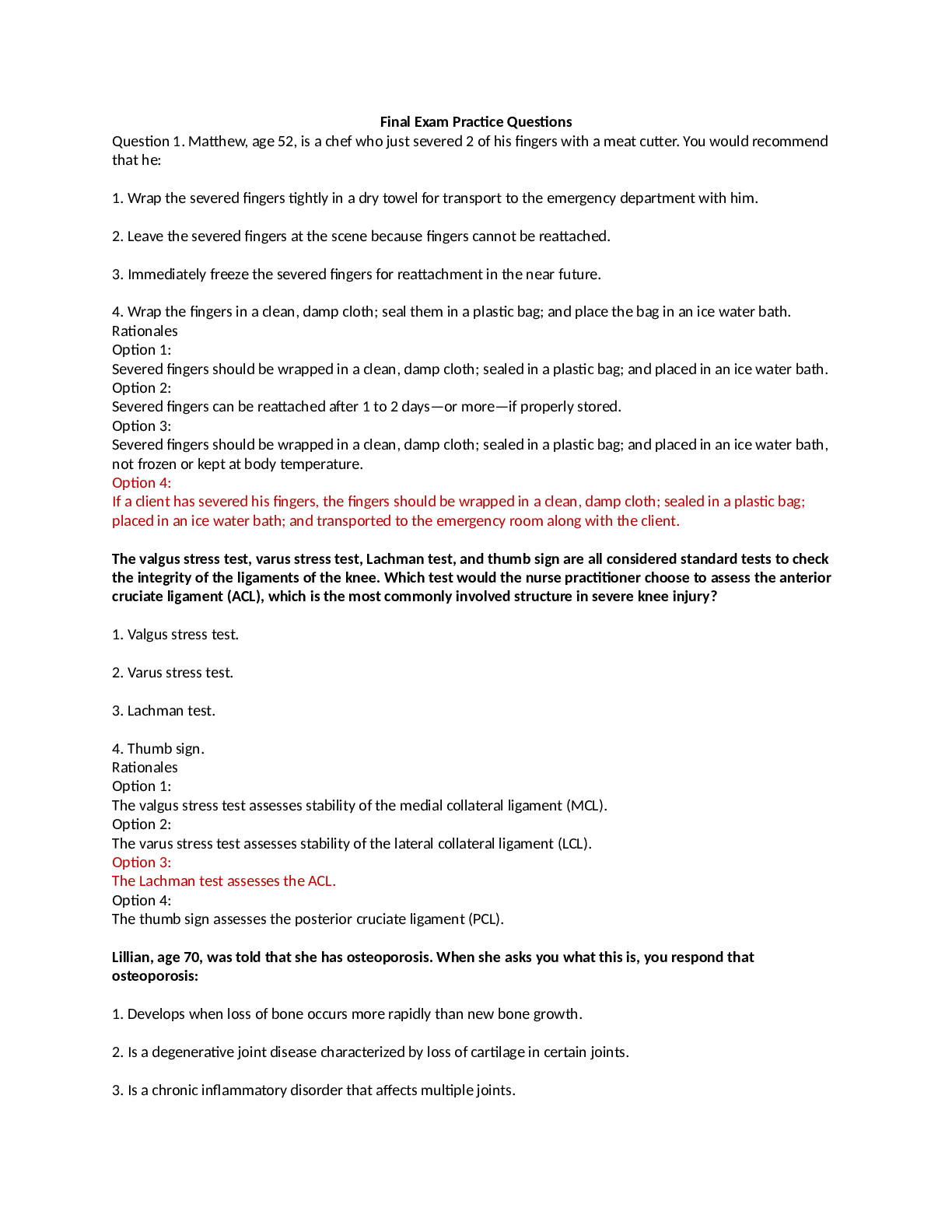
Buy this document to get the full access instantly
Instant Download Access after purchase
Add to cartInstant download
Reviews( 0 )
Document information
Connected school, study & course
About the document
Uploaded On
Aug 05, 2021
Number of pages
127
Written in
Additional information
This document has been written for:
Uploaded
Aug 05, 2021
Downloads
0
Views
52


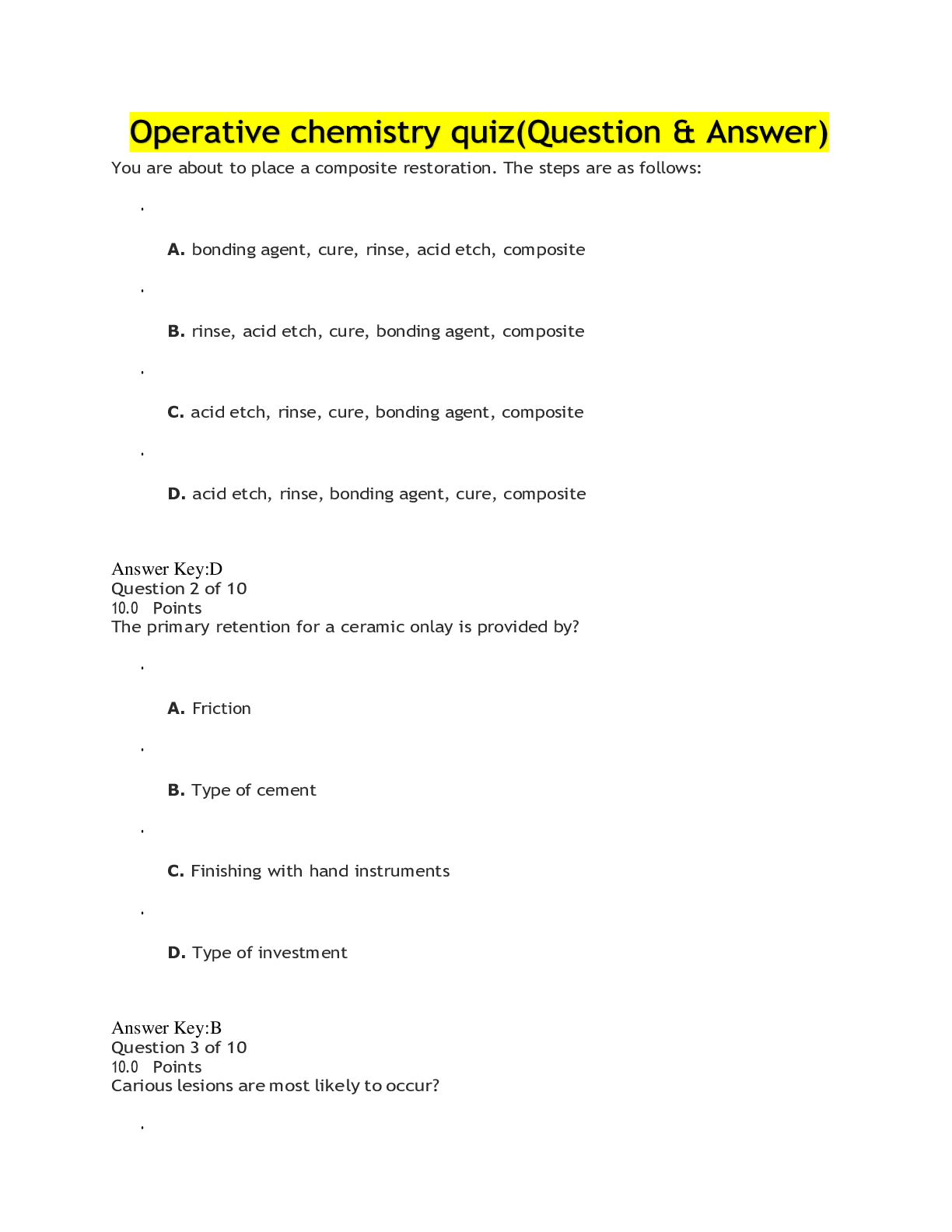

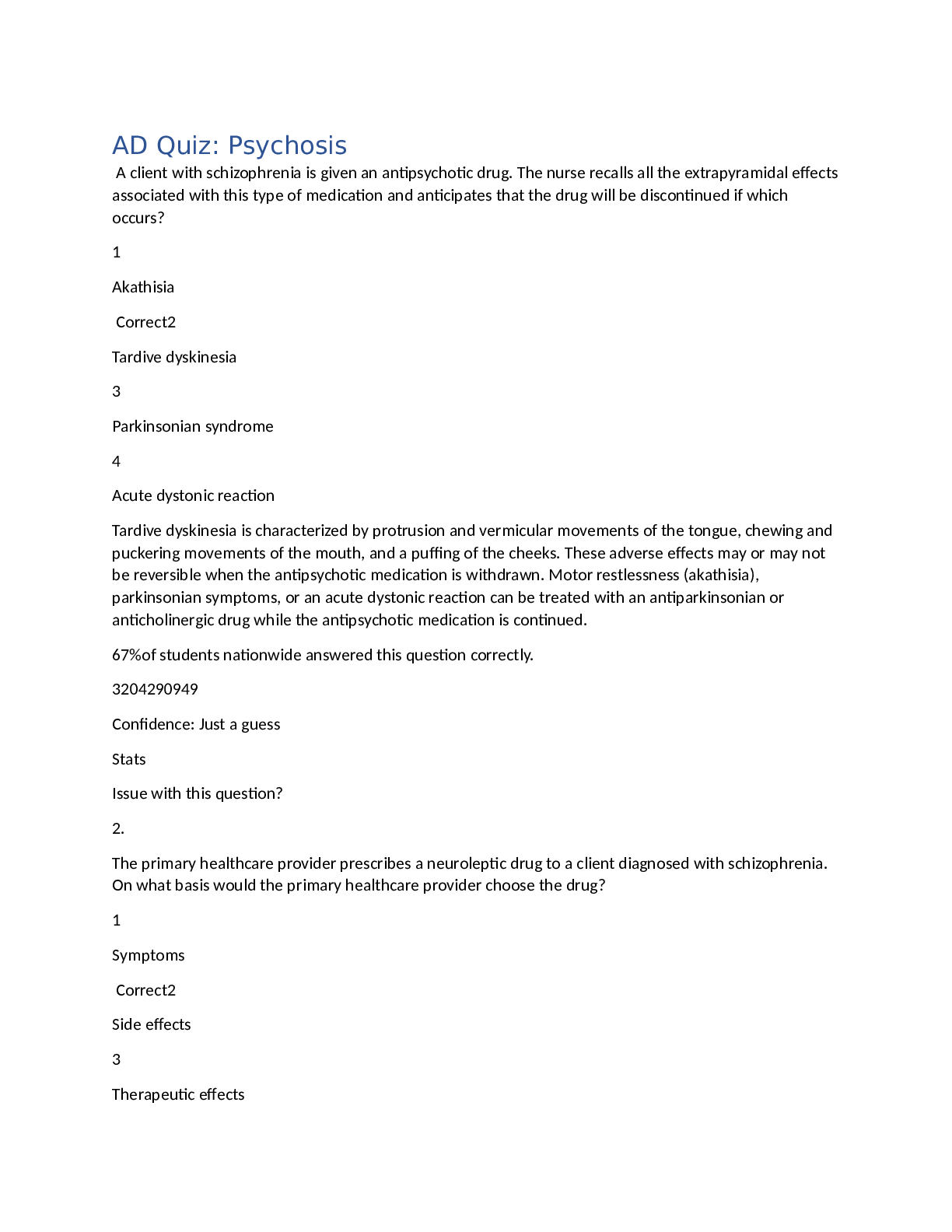
 (1).png)
 q&a.png)



.png)


